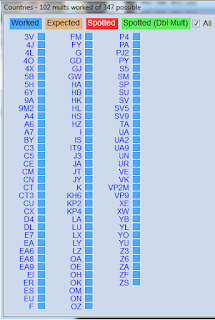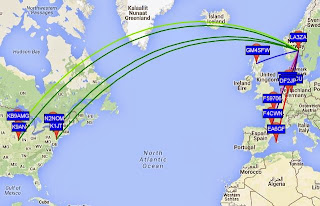Author Archive
 CQ WPX made my day
CQ WPX made my day
From time to time I have heard of those of who manage to contact 100 DXCC countries during one weekend. This past weekend it was my turn to try.
If you have a contest station with 1 kW and monoband yagi antennas, then this goal shouldn’t be too hard. But for my station with only an 80 m horizontal loop (loop skywire) circling its way through my garden from treetop to treetop and 100 W of transmitter power from my K3, the challenge was greater.
About 6 hours before the end of the test and with 87 countries, I had almost given up so I sent the tweet above. The status for the second day of the contest was that I had only worked two more countries.
 But then in the final hours I heard and then contacted Tunisia, Malaysia, Australia og Kosovo (Z6) to bring me to 91, and then Laos and Albania. But then it took a long while for some new ones: Spanish Africa (EA9) and Argentine. I also managed two more Caribbean stations (J3 and CO) and Peru and Sardinia.
But then in the final hours I heard and then contacted Tunisia, Malaysia, Australia og Kosovo (Z6) to bring me to 91, and then Laos and Albania. But then it took a long while for some new ones: Spanish Africa (EA9) and Argentine. I also managed two more Caribbean stations (J3 and CO) and Peru and Sardinia.
Finally in the last hour of the contest two more Caribbean stations (PJ2 and VP9) and in the end Mexico 21 minutes before the end of the contest. That brought the total to 102. I think that was needed as Kosovo isn’t really an approved country and I also had contact with what was probably a pirate and not a station from Andorra. That signature was C31XR which most likely is the name of an antenna and not a real station.
My total was 47 European countries, 19 from Asia, 12 from North America, 10 from Africa, 9 from South America and 3 from Oceania. I think it helps to be in Europe as I had almost half of the countries quite close by, but it would be interesting to hear comments from North Americans on how realistic they consider this goal to be from their location.
 Where can I get APF and DIV stickers for my K3?
Where can I get APF and DIV stickers for my K3?
The updated Elecraft K3, the K3S has some nice improvements that would be nice to have, but which I also can live fine without. But even an old K3 can be updated to some of these improvements They are detailed on the Elecraft K3S FAQ.
I studied the front panel for differences and put red rings around them. The three to the upper left have to do with the new display bezel with silver instead of black screws, the S in K3S, a built-in marker for the VFO A knob, and a soft-touch VFO A knob.
In addition to the marking with OFS (offset) to the left of the RIT/XIT control, there are two markings that also reflect what my present K3 with the latest firmware does:
- APF instead of DUAL PB (Audio Peaking Filter – Dual Passband) – upper right
- New marker for DIV – Diversity reception – to the left of VFO A
 Where can I get APF and DIV stickers for my K3?
Where can I get APF and DIV stickers for my K3?
The updated Elecraft K3, the K3S, has some nice improvements that would be nice to have, but which I also can live fine without. But even an old K3 can be updated to some of these improvements. They are detailed on the Elecraft K3S FAQ.
I studied the front panel for differences and put red rings around them. The three to the upper left have to do with the new display bezel with silver instead of black screws, the S in K3S, a built-in marker for the VFO A knob, and a soft-touch VFO A knob.
In addition to the marking with OFS (offset) to the left of the RIT/XIT control, there are two markings that also reflect what my present K3 with the latest firmware does:
- APF instead of DUAL PB (Audio Peaking Filter – Dual Passband) – upper right
- New marker for DIV – Diversity reception – to the left of VFO A
 The ultimate WSPR spot
The ultimate WSPR spot
A spot reported by K1JT must be the ultimate goal for the WSPR mode. K1JT, Joseph Taylor, is the Nobel laureate who first developed this mode and other related two-way modes like JT65 and JT9.
My 0.1 W 21 MHz WSPR transmitter regularly makes it over the Atlantic, but never before to K1JT. The SWR was something like 7:1, but apparently that works fine, both for the transmitter and for radiation.
The antenna is a 13 m doublet oriented with the broadside facing East-West. I feed it with 450 ohm ladder line to a 4:1 Elecraft balun which is connected to the Ultimate 2 transmitter.
 The ultimate WSPR spot
The ultimate WSPR spot
A spot reported by K1JT must be the ultimate goal for the WSPR mode. K1JT, Joseph Taylor, is the Nobel laureate who first developed this mode and other related two-way modes like JT65 and JT9.
My 0.1 W 21 MHz WSPR transmitter regularly makes it over the Atlantic, but never before to K1JT. The SWR was something like 7:1, but apparently that works fine, both for the transmitter and for radiation.
The antenna is a 13 m doublet oriented with the broadside facing East-West (the EU spots in the figure are from my Ultimate 3 on 21 MHz with another antenna and at another location). I feed the doublet with 450 ohm ladder line to a 4:1 Elecraft balun which is connected to the Ultimate 2 transmitter.
 Ultimate software is up to date
Ultimate software is up to date
As I have mentioned several times on this blog, I have thoroughly enjoyed WSPR modes ever since Hans, G0UPL came out with the first Ultimate QRSS/WSPR kit.
That means that I have three different versions of the kit. Since Hans has kept on updating the software and even published the compiled versions, it is also possible to upgrade even the old ones.
I have done that and the displays here show the Ultimate 3, the Ultimate 2, and the Ultimate 1 with the latest software.
It is possible to upgrade the chips in-circuit, but I found that it is simpler to remove the chip temporarily from the socket and move it to a simple veroboard with crystal oscillator components. It is connected to my Ebay version of the USBtinyISP.
 Ultimate software is up to date
Ultimate software is up to date
As I have mentioned several times on this blog, I have thoroughly enjoyed WSPR modes ever since Hans, G0UPL came out with the first Ultimate QRSS/WSPR kit.
That means that I have three different versions of the kit. Since Hans has kept on updating the software and even published the compiled versions, it is also possible to upgrade even the old ones.
I have done that and the displays here show the Ultimate 3, the Ultimate 2, and the Ultimate 1 with the latest software.
It is possible to upgrade the chips in-circuit, but I found that it is simpler to remove the chip temporarily from the socket and move it to a simple veroboard with crystal oscillator components. It is connected to my Ebay version of the USBtinyISP.

















